Calorie and nutritional value of buckwheat, as well as its benefits for the body
Adherents of a healthy lifestyle and supporters of dietary nutrition often ask themselves the question of how to correctly calculate the calorie content of buckwheat - take into account the energy value of raw grains or ready-made porridge? We will tell you about the system for calculating the calorie content of a product in raw and finished form per 100 g and in portions, about the nutritional value and beneficial properties of buckwheat.
The content of the article
Calorie buckwheat
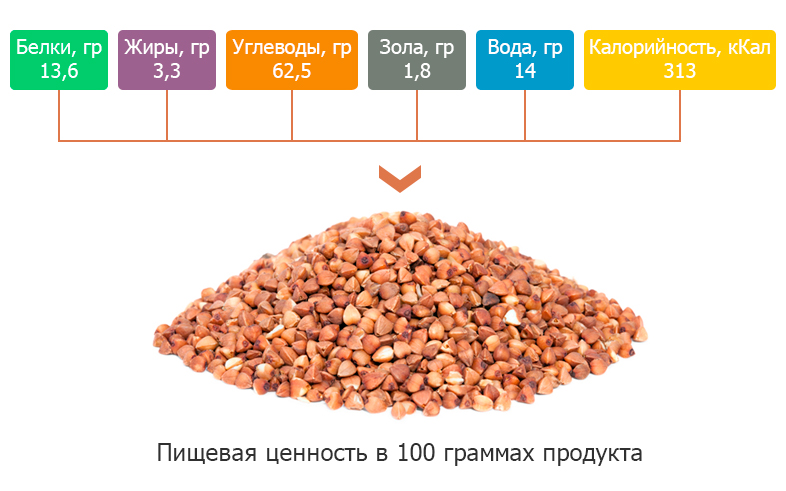
That buckwheat grain - the most important product for the domestic consumer, needless to say. The situation with self-isolation has confirmed this - the people voted for buckwheat with a ruble. Buckwheat is available, nutritious and equally useful for children, adults, people with special nutritional needs (diabetes, pregnancy, gastrointestinal tract pathologies, etc.).
Before calculating the daily diet and calorie content, it is important to consider several features:
- Nutritional values and the chemical composition of raw buckwheat and cereals vary considerably. With any processing (boiling, steeping, steaming), the grains increase in weight by 2-3 times. Accordingly, for 100 g of dry grains, a portion of 200-250 g of the finished dish is obtained at the exit.
- The nutritional value depends on the quality of the grain pretreatment. So unground (whole grain grain, the top layer, husk is removed during processing) contains more nutrients. The kernel as a top quality cereal is used in dietetics and baby food. For crushed grains, chaff, flakes, flour, the percentage of useful carbohydrates is reduced by 3-5%.
- Calorie content depends on the method of cooking porridge (in butter, milk, broth, garnish with meat and (or) vegetables).
Boiled
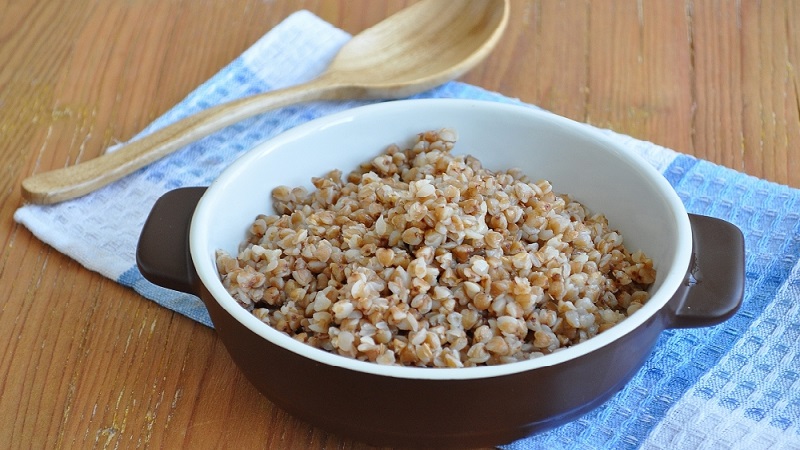
Initially, consider the indicators of energy value buckwheatcooked in water, without salt and oil.
100 g of ready-made crumbly porridge accounts for 88.8-98 kcal.
A 200 g serving of garnish (no butter and salt) contains about 200 kcal.
300 g boiled buckwheat contains 280-300 calories, depending on the type of cereal.
Dry cereals
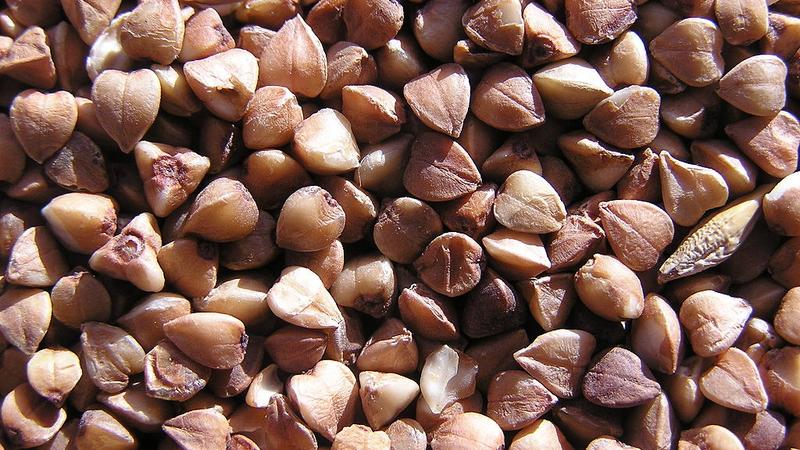
To calculate the energy value of bulk products, you need to take into account their volume.
Whole grain buckwheat:
- glass (volume 250 sq. cm) - 205-210 g;
- 1 tbsp. l. - 12-15 g;
- 1 tsp - 6-7 g.
100 g of dry kernels contain 307-310 kcal. Accordingly, in 1 tbsp. l. - up to 47 kcal.
1 cup (210 g) of raw cereals contains up to 650 kcal.
Nutritional and energy value (BZHU and other substances)
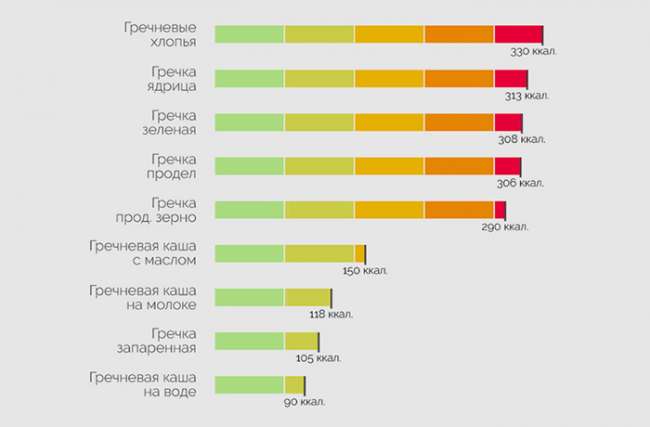
BZHU buckwheat kernels (in 100 g):
- 10-10.8 g of protein;
- 3-3.2 g fat;
- 50-56 g of carbohydrates.
The percentage is 15.7%: 3.18%: 80.3%.
BZHU ready-made crumbly porridge (without additives, in water and without salt). 100 g of product:
- 4.63-5 g protein;
- 1.7-2.14 g of fat;
- 19.5-22.9 carbohydrates.
Percentage (average) - 16%: 7%: 77%.
Reference. During cooking, the initial composition indicators are reduced by at least 20%.
In a 100 g portion of ready-made porridge, macro- and microelements (in mg) are preserved in water:
- potassium - up to 126;
- phosphorus - up to 99;
- magnesium - 67;
- sulfur about - 30;
- silicon - up to 26.7;
- chlorine - 12;
- iron - up to 2-2.5;
- sodium - 1.8;
- manganese - 0.5-0.6;
- calcium - 10.
Trace elements (in μg) are preserved in small quantities in finished form:
- copper - 218;
- fluorine - 87;
- titanium - 11;
- nickel - up to 3.2;
- iodine, cobalt, selenium, chromium and zinc - 1-2.
Zirconium, aluminum, lithium, rubidium disappear during heat treatment.
During cooking, the amount of vitamins is also reduced: vitamins of group B, PP - by 20-25%; vitamins A, K, E - up to 50%.
Council. To reduce the loss of nutrient composition, it is advisable not to boil the cereals, but to steam them with boiling water. With this method of preparation, the beneficial properties are preserved by 70-80%.
How to correctly calculate the calorie content of buckwheat
The energy value of buckwheat is based on the calorie content of the finished dish. This takes into account grade and the quality of raw grains, additives and cooking technology.
On a note. To accurately calculate the daily portion, use measured indicators: in 1 tsp. contains 4.5-5 g of ready-made porridge, in 1 tbsp. l. - 19-20 g.
The benefits of buckwheat for the body (+ for weight loss)
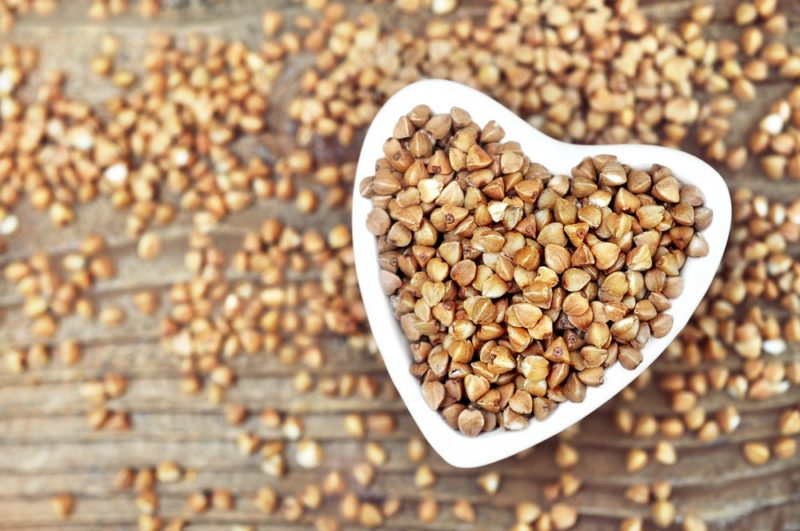
Lean porridge is a versatile dietary product that is included in the diet in sanatoriums, hospitals, kindergartens and schools. Pediatricians recommend using it as the first complementary foods for children under 1 year old.
Useful properties of the product:
- there is no glucose in the product, cereals are allowed to be included in the menu for diabetics, it does not provoke jumps in sugar, has a low glycemic index - 50-60 (an indicator of the rate of absorption of carbohydrates), while providing useful fuel-glycogen to muscle tissue,
- due to "long carbohydrates" and fiber, it provides saturation for a long time;
- magnesium and manganese affect blood composition and hematopoiesis processes, reduce the level of bad cholesterol, resist the formation of blood clots;
- pediatricians emphasize that phosphorus is necessary for children, prevents anemia and rickets, maintains the mineralization of bone tissue and teeth;
- vitamins and microelements, dietary indigestible fibers optimize the intestinal tract, improve peristalsis, remove salts of heavy metals and harmful substances from the body;
- protein is involved in the formation of cells, muscle tissue;
- a large amount of carbohydrates provides energy, increases endurance and performance;
- fatty acids are responsible for the health of nails and hair, such as linolenic acid.
For men
The iron in buckwheat maintains efficiency. Resists skeletal muscle atony, myocardiopathy.
Copper is an activator of the redox function of enzymes, promotes the assimilation carbohydrates and proteins... The element helps to transport oxygen to tissues, counteracts the development of connective tissue dysplasia.
Manganese is essential for the formation of bone and connective tissue. Supports reproductive function, normalizes fat and carbohydrate metabolism.
For women
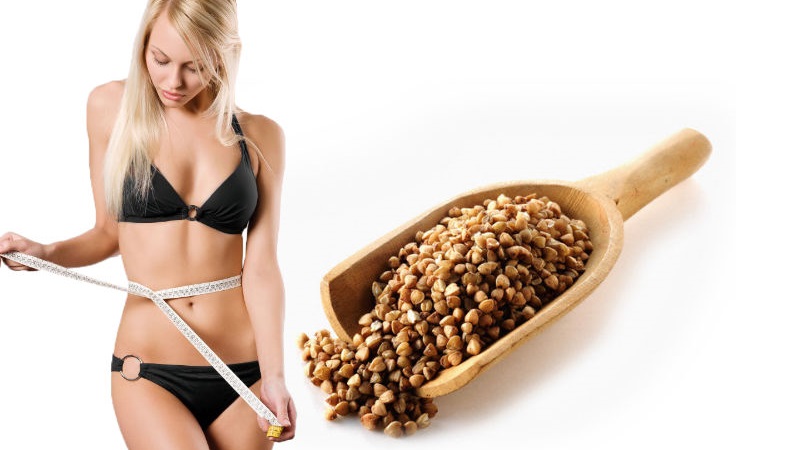
Porridge helps to normalize metabolic processes thanks to fiber and minerals, bowel function (eliminates constipation).
Maintains the balance of the bacterial composition of the microflora of the large intestine, the effect of buckwheat is equated with prebiotics. Phosphorus, magnesium are participants in energy metabolism.
For reference... 100 g of buckwheat porridge on water contains about 20% of the daily value of coarse fibers.
Nutritionists recommend including in the diet buckwheat porridge in water (no more than 200 g per day) with vegetables and boiled lean meat to normalize weight.
Magnesium reduces the risk of developing hypertension. The product is especially valuable for women during menopause, with age-related changes in the body.
Silicon is involved in collagen synthesis, helping to maintain skin firmness and youthfulness.
With the addition of other ingredients
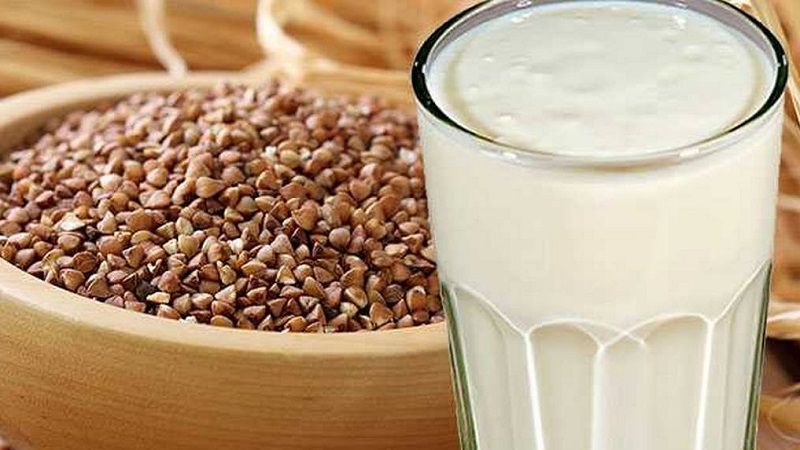
Nutritionists and healthy lifestyle experts warn that effectiveness buckwheat diets for weight loss is nothing more than a myth. When eating porridge alone, the body loses water, the muscles lose the necessary protein. Losing weight is temporary - all the kilograms will come back.
To bring your weight back to normal, you need a balanced diet and exercise. The diet should include meat, fish and vegetables.
Attention! Overloading the body with carbohydrates (even slow - correct ones) is dangerous to health. The daily allowance for an adult is no more than 200 g of the finished product.
Side dishes with the addition of oil, vegetables and meat, casseroles change the calorie values of buckwheat.
Consider the most common options for cooking buckwheat and energy value at the rate of 100 g:
Calorie content of dishes (kcal per 100 g):
- porridge on water with salt - 105-110;
- flavored with butter (3.5-5 g) - 135-140;
- sweet porridge with milk (1 tsp sugar per 100 g) - 170-195;
- side dish with carrots, onions and boiled chicken - 150-165;
- porridge with mushrooms - up to 90;
- buckwheat casserole - 160-170;
- buckwheat groats with cottage cheese - 200-205;
- Greek people - 155-160;
- porridge with butter (5 g) and a beaten egg, omelet - 150-155;
- buckwheat with fermented baked milk - up to 100.
Kefir
On fasting days or for breakfast, doctors recommend using buckwheat porridge (without oil and salt) with fermented milk products (kefir, unsweetened yogurt, yogurt, fermented baked milk).
The calorie content of such a dish is 100-110 calories per 100 g, depending on the fat content of dairy products.
Porridge with the addition of kefir 0% fat contains about 60 calories per 100 g.
The method of preparation is simple - the prepared porridge is poured with cold fermented baked milk or kefir to taste, or raw cereals Pour kefir overnight in a ratio of 1: 2.
Milk

Milk porridge - a high-calorie dish, especially if you add sugar and butter. A 100-gram portion contains 178-250 kcal, depending on the fat content and the amount of milk.
Accordingly, the indicators of BZHU (in g) increase - 15-17: 20-26: 60-80.
In 100 g of milk with an average fat content of up to 2% - 48-50 kcal, up to 6% - 85-90 kcal.
Conclusion
Buckwheat is a useful, affordable and nutritious product, which is dominated by complex carbohydrates and protein. For a balanced and nutritious diet, the menu includes vegetables, dairy and meat products. The mineral and vitamin composition of the product does not provide 100% of the daily supply of nutrients, vitamins, fats and amino acids.
The finished product, with moderate use, has no contraindications and side reactions. It is included in the diet of patients with gastrointestinal tract pathologies, diabetes mellitus. Buckwheat porridge is a dietary product that does not have age restrictions. It is useful for athletes, elderly people and those who are engaged in hard physical work, as well as schoolchildren and preschoolers.